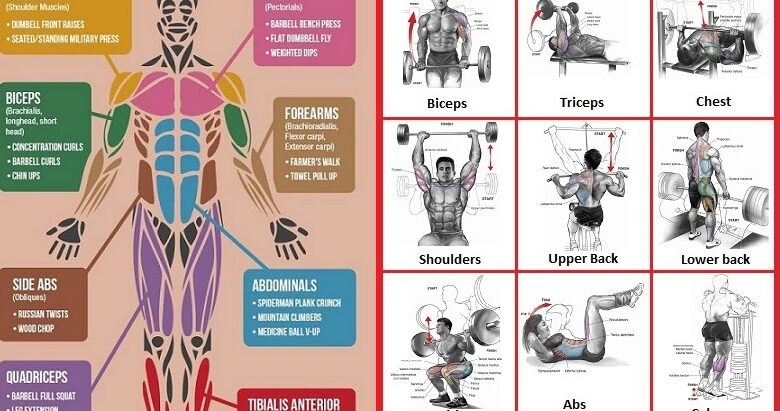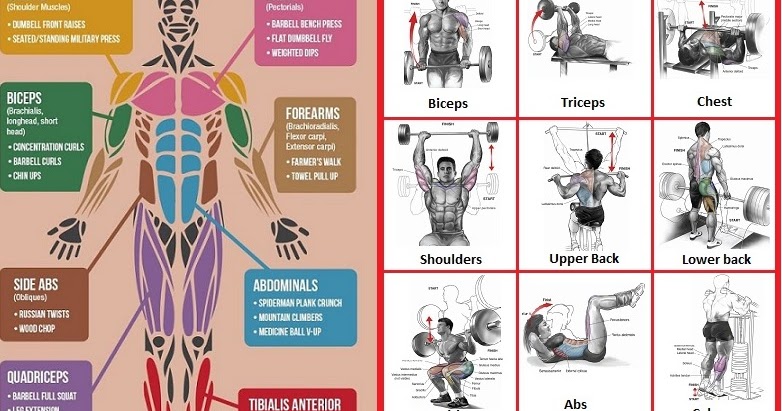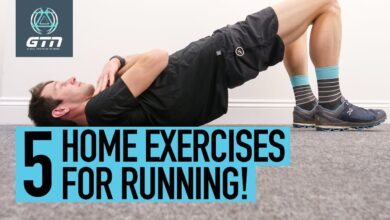
20 Minute Full Body Dumbbell Workout: A Time-Efficient Strength Builder
20 Minute Full Body Dumbbell Workout: Who says you need hours to get a great workout? This efficient routine leverages the power of dumbbells to sculpt your entire body in just 20 minutes, making it perfect for busy schedules or those seeking a quick yet effective strength session.
Whether you’re a seasoned gym-goer or a beginner, this workout can be tailored to your fitness level, offering a challenging yet achievable path to building muscle and boosting your overall fitness.
The key to this workout’s effectiveness lies in its full-body approach. By targeting multiple muscle groups simultaneously, you maximize your workout’s impact, boosting your metabolism and burning more calories even after you’ve finished. And the use of dumbbells adds a dynamic element, challenging your muscles in new ways and helping you build strength and definition.
But remember, proper form is crucial to avoid injuries and maximize results. So, before you dive in, take the time to learn the correct technique for each exercise. We’ll cover all that in this blog post.
Full Body Dumbbell Workout: 20 Minutes to a Stronger You

This 20-minute full-body dumbbell workout is designed to help you build strength, increase muscle mass, and improve your overall fitness. Dumbbell workouts offer a versatile and effective way to challenge your body, as they require you to engage multiple muscle groups simultaneously.
Why 20 Minutes Can Be Effective
You might be thinking, “20 minutes? Is that enough?” The answer is a resounding yes! Short, intense workouts like this can be incredibly effective for building muscle and improving fitness. Here’s why:
- Time Efficiency:A 20-minute workout is easily incorporated into even the busiest schedules. You can fit it in before work, during your lunch break, or after dinner.
- Increased Intensity:When you have limited time, you tend to push yourself harder, leading to greater results.
- Reduced Risk of Injury:Short, intense workouts are less likely to lead to overuse injuries.
Importance of Warm-up and Cool-down
While a 20-minute workout may seem short, it’s essential to prepare your body for the challenge and allow it to recover properly. This means prioritizing a proper warm-up and cool-down.
- Warm-up:A warm-up increases your heart rate, improves blood flow, and prepares your muscles for exercise. It can include light cardio, dynamic stretches, and bodyweight exercises.
- Cool-down:A cool-down helps your body gradually return to a resting state. It should involve static stretches, focusing on the muscle groups you worked during the workout.
Workout Routine
This 20-minute full-body dumbbell workout is designed to challenge your muscles and help you build strength and endurance. It’s a perfect option for those short on time but still want a comprehensive workout. The routine consists of four exercises targeting different muscle groups.
Exercise Selection and Order
This workout is structured to work through major muscle groups in a logical order, minimizing fatigue and maximizing effectiveness.
- Dumbbell Squats:This compound exercise targets your quads, glutes, and hamstrings, providing a strong foundation for the rest of the workout.
- Dumbbell Bench Press:This exercise focuses on your chest, front shoulders, and triceps, ensuring a balanced upper body workout.
- Dumbbell Rows:This exercise targets your back and biceps, building strength and improving posture.
- Dumbbell Overhead Press:This exercise strengthens your shoulders and triceps, promoting overall upper body strength.
Sets and Reps
- Dumbbell Squats:3 sets of 10-12 repetitions.
- Dumbbell Bench Press:3 sets of 10-12 repetitions.
- Dumbbell Rows:3 sets of 10-12 repetitions.
- Dumbbell Overhead Press:3 sets of 10-12 repetitions.
Rest Periods
Rest for 60 seconds between each set. This allows your muscles to recover and prepare for the next set.
Workout Structure
Perform each exercise in the order listed above, completing all sets of one exercise before moving on to the next.
Remember to choose a weight that challenges you but allows you to maintain proper form throughout each set.
Exercise Examples: 20 Minute Full Body Dumbbell Workout
This section provides examples of exercises you can incorporate into your 20-minute full-body dumbbell workout. Each exercise targets specific muscle groups, promotes strength and endurance, and can be modified to suit your fitness level.
Dumbbell Exercises for a Full-Body Workout
Here’s a table that Artikels the exercises, target muscle groups, descriptions, and visual representations.
| Exercise Name | Target Muscle Group | Description | Illustration/Image |
|---|---|---|---|
| Dumbbell Squat | Quadriceps, glutes, hamstrings | Stand with feet shoulder-width apart, holding dumbbells at shoulder height. Lower your hips as if sitting in a chair, keeping your back straight and core engaged. Push through your heels to return to the starting position. | Image: A person standing with feet shoulder-width apart, holding dumbbells at shoulder height. They are lowering their hips as if sitting in a chair, keeping their back straight and core engaged. They are pushing through their heels to return to the starting position. |
| Dumbbell Bench Press | Chest, triceps, shoulders | Lie on a bench with feet flat on the floor. Hold dumbbells above your chest, palms facing each other. Lower the dumbbells towards your chest, keeping your elbows slightly bent. Push the dumbbells back up to the starting position. | Image: A person lying on a bench with feet flat on the floor. They are holding dumbbells above their chest, palms facing each other. They are lowering the dumbbells towards their chest, keeping their elbows slightly bent. They are pushing the dumbbells back up to the starting position. |
| Dumbbell Row | Back, biceps | Stand with feet shoulder-width apart, holding dumbbells in front of your thighs. Hinge at your hips, keeping your back straight and core engaged. Pull the dumbbells towards your chest, keeping your elbows close to your body. Lower the dumbbells back to the starting position. | Image: A person standing with feet shoulder-width apart, holding dumbbells in front of their thighs. They are hinging at their hips, keeping their back straight and core engaged. They are pulling the dumbbells towards their chest, keeping their elbows close to their body. They are lowering the dumbbells back to the starting position. |
| Dumbbell Overhead Press | Shoulders, triceps | Stand with feet shoulder-width apart, holding dumbbells at shoulder height. Press the dumbbells straight up above your head, keeping your elbows slightly bent. Slowly lower the dumbbells back to the starting position. | Image: A person standing with feet shoulder-width apart, holding dumbbells at shoulder height. They are pressing the dumbbells straight up above their head, keeping their elbows slightly bent. They are slowly lowering the dumbbells back to the starting position. |
| Dumbbell Bicep Curl | Biceps | Stand with feet shoulder-width apart, holding dumbbells in front of your thighs, palms facing up. Curl the dumbbells up towards your shoulders, keeping your elbows close to your body. Slowly lower the dumbbells back to the starting position. | Image: A person standing with feet shoulder-width apart, holding dumbbells in front of their thighs, palms facing up. They are curling the dumbbells up towards their shoulders, keeping their elbows close to their body. They are slowly lowering the dumbbells back to the starting position. |
| Dumbbell Triceps Extension | Triceps | Stand with feet shoulder-width apart, holding a dumbbell with both hands behind your head, palms facing your body. Extend your arms straight up, keeping your elbows close to your ears. Slowly lower the dumbbell back to the starting position. | Image: A person standing with feet shoulder-width apart, holding a dumbbell with both hands behind their head, palms facing their body. They are extending their arms straight up, keeping their elbows close to their ears. They are slowly lowering the dumbbell back to the starting position. |
| Dumbbell Lunges | Quadriceps, glutes, hamstrings | Stand with feet hip-width apart, holding dumbbells at your sides. Step forward with one leg, lowering your hips until both knees are bent at a 90-degree angle. Push through your front heel to return to the starting position. Repeat with the other leg. | Image: A person standing with feet hip-width apart, holding dumbbells at their sides. They are stepping forward with one leg, lowering their hips until both knees are bent at a 90-degree angle. They are pushing through their front heel to return to the starting position. They will repeat with the other leg. |
| Dumbbell Deadlifts | Back, hamstrings, glutes | Stand with feet hip-width apart, holding dumbbells in front of your thighs. Hinge at your hips, keeping your back straight and core engaged. Lower the dumbbells towards the floor, keeping your knees slightly bent. Push through your hips and legs to return to the starting position. | Image: A person standing with feet hip-width apart, holding dumbbells in front of their thighs. They are hinging at their hips, keeping their back straight and core engaged. They are lowering the dumbbells towards the floor, keeping their knees slightly bent. They are pushing through their hips and legs to return to the starting position. |
Safety and Precautions
Dumbbell workouts offer a fantastic way to build strength and improve overall fitness. However, like any exercise routine, safety should always be your top priority. Understanding proper form, common mistakes to avoid, and injury prevention strategies is crucial for a successful and injury-free workout experience.
Importance of Proper Form and Technique, 20 minute full body dumbbell workout
Proper form and technique are fundamental to a safe and effective dumbbell workout. When you execute exercises with correct form, you maximize muscle activation, reduce the risk of injuries, and enhance your overall results.
- Maintain a Neutral Spine:During exercises like rows, bicep curls, and shoulder presses, keep your spine straight and avoid excessive arching or rounding. A neutral spine helps distribute weight evenly and protects your lower back.
- Control the Movement:Avoid swinging the dumbbells or using momentum to lift the weight. Focus on controlled movements throughout the entire range of motion. This ensures proper muscle engagement and minimizes strain on joints.
- Engage Core Muscles:Engage your core muscles throughout the workout. This helps stabilize your body, preventing unnecessary strain on your back and other areas.
- Full Range of Motion:Complete each exercise through a full range of motion, allowing for maximum muscle activation. However, avoid going beyond your natural range of motion to prevent joint stress.
Common Mistakes to Avoid
Understanding common mistakes during dumbbell workouts can help you stay safe and optimize your results.
A 20-minute full body dumbbell workout is a great way to get a quick and effective workout in, especially if you’re short on time. But if you’re following a low-carb diet, it’s important to consider the quality of carbs you’re consuming to ensure you’re fueling your workouts properly.
Read more about why quality of carbs matters on a low carb diet to understand how to maximize your energy and performance during your 20-minute dumbbell workout.
- Lifting Too Heavy:Starting with weights that are too heavy can lead to poor form, muscle strain, and potential injuries. It’s essential to choose a weight that allows you to maintain proper form throughout the entire set.
- Ignoring Warm-Up:Skipping a warm-up can increase the risk of muscle strains and injuries. Before your workout, perform light cardio and dynamic stretching to prepare your muscles for the demands of exercise.
- Using Momentum:Relying on momentum to lift weights can put unnecessary stress on your joints and compromise your form. Focus on controlled movements and engage the target muscles actively.
- Holding Your Breath:Holding your breath during lifting can increase blood pressure and lead to dizziness or discomfort. Remember to breathe steadily throughout the exercise.
- Ignoring Rest Days:Giving your body adequate rest is crucial for muscle recovery and preventing overuse injuries. Ensure you incorporate rest days into your training schedule.
Tips for Preventing Injuries
Several preventative measures can help minimize the risk of injuries during dumbbell workouts.
- Start Slowly and Gradually Increase Weight:Begin with lighter weights and gradually increase the weight as you get stronger. This allows your muscles to adapt to the demands of exercise.
- Use Proper Equipment:Ensure your dumbbells are in good condition, with no cracks or loose weights. If you are using a bench, make sure it is stable and secure.
- Listen to Your Body:Pay attention to any pain or discomfort during your workout. If you experience any sharp pain, stop the exercise immediately and consult a healthcare professional.
- Maintain Good Posture:Proper posture is essential for preventing back pain and other injuries. Stand tall with your shoulders relaxed and your core engaged.
- Stay Hydrated:Drinking plenty of water before, during, and after your workout helps prevent dehydration and muscle cramps.
Consulting a Healthcare Professional
Before starting any new workout routine, it’s highly recommended to consult with a healthcare professional, especially if you have any underlying health conditions. They can provide personalized advice and ensure the workout plan is safe and appropriate for your individual needs.
Nutrition and Recovery
This section delves into the vital connection between nutrition and muscle growth and recovery, offering insights into optimizing your diet to enhance your workout results.
A 20-minute full-body dumbbell workout is a great way to get a quick and effective workout in, but it’s important to fuel your body properly afterward. Check out these diets and recipes for 35 minute dinners for some healthy and delicious meal ideas.
That way, you can recover from your workout and be ready for your next one!
Importance of Nutrition for Muscle Growth and Recovery
Nutrition plays a pivotal role in muscle growth and recovery. It provides the building blocks your body needs to repair muscle tissue damaged during exercise and to build new muscle protein.
Pre-Workout Meals
A pre-workout meal should provide your body with sustained energy, preventing fatigue and supporting optimal performance. Here are some recommendations:* Carbohydrates:These provide energy for your workout. Choose complex carbohydrates like whole-grain bread, brown rice, or oatmeal.
Protein
A 20-minute full body dumbbell workout is a great way to get a quick and effective workout in. You can use dumbbells for a variety of exercises, such as squats, lunges, rows, and presses. If you’re looking for some inspiration for what to cook after your workout, check out this article on amazing things to do with a dutch oven.
After a great workout, a delicious meal made in a Dutch oven will be the perfect reward! I’m sure you’ll find plenty of delicious recipes that will fuel your body for your next workout.
Healthy Fats These help with energy release and hormone production. Include sources like avocado or nuts.
Post-Workout Meals
A post-workout meal is crucial for replenishing energy stores and promoting muscle recovery. It’s essential to consume a combination of carbohydrates and protein. Here are some suggestions:* Carbohydrates:Choose complex carbohydrates like sweet potatoes or quinoa.
Protein Include protein sources like Greek yogurt, whey protein, or cottage cheese.
Hydration
Adequate hydration is vital for overall health and performance, especially during exercise.
Water is essential It helps regulate body temperature, transport nutrients, and remove waste products.
Dehydration can negatively impact Exercise performance, increase fatigue, and hinder muscle recovery.
Recommended intake Aim for 8-10 glasses of water per day, increasing intake during and after workouts.
Optimizing Sleep for Muscle Recovery
Sleep is essential for muscle recovery and growth.
During sleep Your body releases hormones that promote muscle repair and growth.
Lack of sleep Can hinder muscle recovery and lead to decreased performance.
Aim for 7-9 hours of quality sleep each night to maximize recovery and enhance your workout results.
Progression and Variations
This 20-minute dumbbell workout is a great starting point for building strength and endurance. As you get stronger, you can progressively challenge yourself by increasing the weight, repetitions, or sets. You can also mix up the exercises to keep your body guessing and prevent plateaus.
Increasing Weight
Increasing the weight you lift is the most common way to progress in strength training. When you can comfortably complete all the repetitions with good form, it’s time to increase the weight. Start by adding 2.5 to 5 pounds to each dumbbell.
Increasing Repetitions
If you find you’re able to do all the repetitions with good form, you can increase the number of repetitions per set. For example, if you’re currently doing 8 repetitions per set, you can increase to 10 or 12.
Increasing Sets
You can also increase the number of sets you do for each exercise. If you’re currently doing 2 sets, you can increase to 3 or 4.
Alternative Exercises
Here are some alternative exercises you can use to keep your workout fresh and challenging:
- Bicep Curls:Hammer curls, concentration curls, preacher curls
- Tricep Extensions:Overhead tricep extensions, close-grip bench press, skull crushers
- Shoulder Press:Lateral raises, front raises, Arnold press
- Squats:Goblet squats, Bulgarian split squats, jump squats
- Lunges:Walking lunges, reverse lunges, side lunges
- Deadlifts:Romanian deadlifts, sumo deadlifts, trap bar deadlifts
- Rows:Bent-over rows, seated rows, dumbbell pullovers
Incorporating Cardio and Bodyweight Exercises
Adding cardio and bodyweight exercises to your routine can enhance your overall fitness and provide additional benefits.
- Cardio:Incorporating cardio exercises like running, swimming, cycling, or jumping jacks can improve your cardiovascular health and endurance. You can either perform cardio before or after your dumbbell workout, or even intersperse it between sets.
- Bodyweight Exercises:Bodyweight exercises, such as push-ups, pull-ups, squats, and lunges, can further challenge your muscles and improve your strength and functional fitness. They can be done as a warm-up, cool-down, or even integrated into your dumbbell routine.
Last Word
So there you have it! A 20-minute full-body dumbbell workout that can fit seamlessly into your busy life. This routine provides a great foundation for building strength and endurance, but don’t be afraid to experiment and find what works best for you.
As you progress, you can increase the weight, reps, or sets to challenge yourself further. Remember, consistency is key, so aim to incorporate this workout into your routine 2-3 times a week for optimal results. And always listen to your body.
If you’re feeling pain, stop and rest. Enjoy the journey, and let’s get stronger together!






